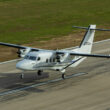The violent turbulence that the Singapore Airlines Boeing 777-300ER, registration 9V-SWM, encountered on flight SQ321 between London and Singapore had very high peaks in vertical speed, data compiled by FlightRadar24 show.
The incident injured several passengers, some seriously, and killed one of them, Briton Geoff Kitchen, who reportedly suffered a massive heart attack. The aircraft ended up diverting to Bangkok, Thailand.
Follow Air Data News: WhatsApp | Google News | Instagram | LinkedIn | Twitter | Facebook
FlightRadar24, which monitors ADS-B records, produced a graph based on high-frequency data from the flight. It is possible to see that the Boeing 777 experienced large peaks in vertical speed, a clear indication of turbulence.
According to the website, the Singapore jet began experiencing turbulence at 07:49 UTC, when it was flying over the sea south of Myanmar.

Vertical rate of 1,500 feet per minute
The unexpected changes in vertical speed reach a rate of about 1,000 feet per minute and then slow to reach 1,700 feet per minute.
The brutal oscillation caused the aircraft to rise about 300 feet in a short period of time. Then comes the first abrupt descent, going from a high positive rate to a negative rate of 1,500 feet per minute and a rapid recovery at 900 feet per minute.

There is a brief moment of minor oscillations and then the last drop with a high vertical rate. Then the widebody regains stability at a slower pace.
FlightRadar24 also clarified erroneous information that ended up circulating in several outlets and said that the Boeing 777 had lost 6,000 feet in altitude. In fact, it was the approach descent.
Officers from the Singapore Transport Safety Investigation Bureau are in Bangkok to begin investigations into the incident.
According to FR24, there were thunderstorms in the region at the time of the turbulence.






